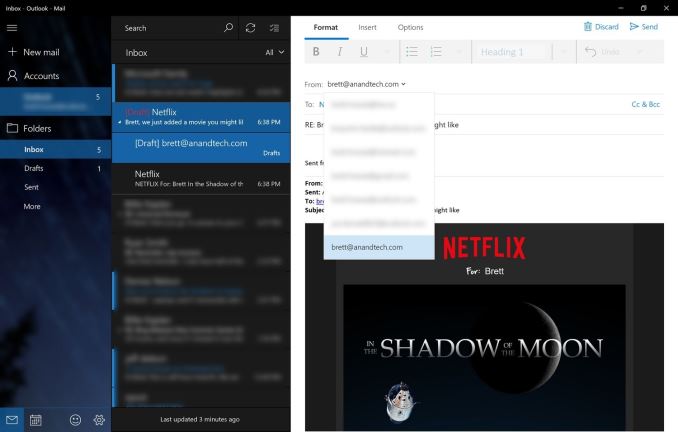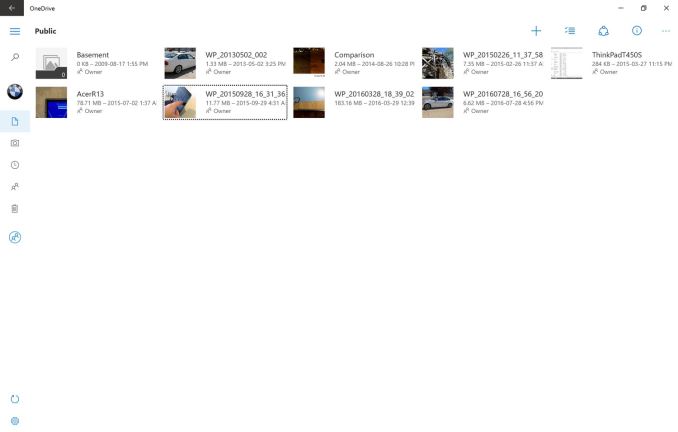Windows 10 Anniversary Update: The Road To Redstone
by Brett Howse on August 2, 2016 8:00 AM EST- Posted in
- Operating Systems
- Microsoft
- Windows 10
New Features And Built-In App Updates
Dark Mode
The Anniversary Update also adds another feature to personalize the experience: Dark Mode. As the name suggests, Dark Mode changes the default color scheme to black. The built-in apps also set their color scheme based on this setting, including mail, the store, and more.
This is certainly a nice feature for personalization, but it’s also a smart idea with recent launches of PCs and tablets with OLED displays. Lenovo showed off their own theme for Windows 10 at CES, for use with their OLED laptops, which eliminates a lot of the bright white display aspects that desktops and laptops have become accustomed to.
Other apps, such as Edge, also include a dark mode but the toggle is in the app settings, so you can customize this the way you prefer.
Mail App
The built-in Mail app hasn’t changed much visually since it was launched, but it’s continued to gain features which were very much missing when the OS first shipped. For instance, the mail client originally shipped with Conversation View as the only way to see your mail. About a month after Windows 10 shipped, an update arrived which allowed you to set the view to the more traditional view of chronological order.
With the Anniversary Update, Microsoft has finally fixed another missing feature which was a huge inconvenience for many people (myself included) which is you can finally send mail as another address. The Windows 8.1 mail client supports this, Microsoft’s Outlook.com supports this, but until this update, the Windows 10 mail client was missing this. You could of course put multiple accounts into it, but if you’ve consolidated to one, you can now use a drop-down selection on the send address to pick any addresses configured.
OneDrive
The OneDrive experience changed dramatically with Windows 10. Windows 8.1 featured the ability to see all of your files in OneDrive, and only download those that you wanted to access. Windows 10 ditched that and went with a per-folder sync when OneDrive was configured. With the limited storage on many devices, this wasn’t always ideal. To compound matters, there was no app for OneDrive when the OS launched.
At least one of these issues is now gone, and while not tied to the Anniversary Update, there is now an app to access OneDrive. It does give access, and you can download files that you need, although it’s a traditional file-save dialog rather than just download it and keep the file in sync within the OneDrive folder like in Windows 8.1.
There were reports of placeholders coming back to Windows 10, but at least so far, there hasn’t been any official word of this feature coming back. Until a new solution is found, OneDrive is not be the integrated experience it was in Windows 8.1.













194 Comments
View All Comments
jlabelle2 - Tuesday, August 16, 2016 - link
- how many of us want a private, customizable (think no Cortana / Store / forced updates / automatic removal of programs) OS?It is not because they are idiot people out there that Microsoft should cater their OS for those.
Cortana is nothing more than a search if you disable all the tailor made options.
Removing Windows Store is like asking that OS would run without softwares and cars without wheels. Store apps have inherent advantages compared to Win32 programs (more secured, uninstall without leftovers, free up memory automatically, scale perfectly, support all input types, integrate with notification center / share API / Cortana, roam the settings accrias devices...) that make them (when they do what you want) factually better that Win32 programs. Nobody is forcing anyone to install them but removing the Store is just an utterly silly request.
And at last, regarding automatic updates, we all know, reading those forums what is the perception of average Joe toward Windows PCs being prone to viruses / malwares / slow down compared to tablets like iPad and this is the smartest decision from Microsoft to force update and back in Windows Defender plus Store apps to give people the same advantages as iPad in term of simplicity / security / continuity of performance while still allowing users to use the millions of legacy Win32 programs if necessary.
jlabelle2 - Tuesday, August 16, 2016 - link
What is Cortana if you removed all points of interest except a glorified search? Why people are asking the possibility to disable Cortana? This is beyond me especially people that do think they understand computer better that my mom. Do not want to use search, do not. Simply as that.looncraz - Tuesday, August 2, 2016 - link
This is basically an article highlighting all of the things I remove from Windows 10 to make it a palatable platform. Except Bash.Dark mode also works in the original Windows 10, you just have to manually set a registry key.
baka_toroi - Tuesday, August 2, 2016 - link
Call me paranoid, but I see the combination of project Centennial and the impossibility of rejecting Windows updates as a surefire way to block Win32 apps in the distant future. "We know better than you, boy. Don't try to do as you wish to do with your own computer." In other words, an Apple world.Sure, there will be jailbreaks and stuff but we all know it's not the same as having legitimate access to your whole system.
Michael Bay - Tuesday, August 2, 2016 - link
That day sure is coming, but not any time soon. Way too much legacy sw still in active circulation.prophet001 - Tuesday, August 2, 2016 - link
Why do people just swallow this hook line and sinker?I know why: Ignorance.
Michael Bay - Tuesday, August 2, 2016 - link
If you`re not using some banking client from 80s, there is little use in holding on tightly to win32. It`s not like they are restricting your ability to develop under winrt and will likely start some kind of transition program for developers like Apple did.Ascaris - Wednesday, August 3, 2016 - link
Win32 programs are for regular desktop or laptop PCs. UWP is for tablets and phones. There's already too much of the horrendous UWP "design language" in desktop Windows 10-- I'm certainly never going to add to it with anything "app." When I had a Windows 10 installation on my test PC, I uprooted Windows Store, Cortana, Edge, and all of that kind of stuff... most satisfying thing I ever did with 10, other than wiping the drive when I finally gave up on 10 ever becoming a usable OS.All the stuff about "it uninstalls cleanly" that we hear about UWP is certainly a good thing, but there's nothing inherent about Win32 that makes this inevitable (other than the existence of the registry in general). In the Win 95 days and prior, Windows pretty much allowed any installer to make any change it wanted. It was common for installers to sprinkle DLLs into the Windows directory, sometimes overwriting system files. They were allowed to do most anything with the registry. There was no enforced or even theoretical schema to any of it... it was just "do whatever you want."
A big part of Windows 95's crashiness can probably be directly attributed to this.
Later versions tightened it up some, but installers still have considerable authority to make changes that are not adequately tracked by the system. That doesn't have to be.
If the changes with UWP were mainly about fixing this, that would be one thing, but that's not the main reason for it. It's so "apps" can run on multiple platforms. Maybe some people will be happy running phone apps on their PCs, but I won't. Too many compromises have to be made to make it sorta-work on devices as dissimilar as a touch-screen 5 inch phone (that is usually held in portrait) and a PC with three times the CPU and GPU power and nearly unlimited local storage with a 24" screen that is always in landscape, with input via an actual keyboard and a mouse.
Of course, I know that the idea is that some "apps" will be strictly PC, but those are not the point of UWP. The point is trying to unify dissimilar and ergonomically incompatible computing platforms, even though there are good reasons why PC and mobile UI design parameters are different and distinct.
jlabelle2 - Tuesday, August 16, 2016 - link
- Win32 programs are for regular desktop or laptop PCs. UWP is for tablets and phonesThis cannot be further of the truth. This is an arbitrary split that you are spreading as if everything should be split like Apple decided (even if they are themselves coming back from those toaster/fridge complain as the iPad Pro is proving).
The one advantage you claim from UWP is real. And many others are. It seems that you would have liked Microsoft to evolve Win32 to integrate all the UWP advantages than starting from scratch. Whatever was the best way to proceed, UWP offers clear and undeniable advantages, even purely on desktop compared to Win32 apps (see some that I mentioned above).
- It's so "apps" can run on multiple platforms
Exactly. And as such, that is already a very important advantage that Win32 does not share. And honestly, mobile being so important these days, it is clear that it is much more clever from Microsoft to push applications that could run as well on laptop, tablet or even mobile phone than legacy Win32 softwares.
- Maybe some people will be happy running phone apps on their PCs, but I won't
I am. Because there are nothing specifically phone related. For instance, Drawboard PDF has simply no Win32 equivalent. And there are plenty examples of those.
And there is no reason why phone apps advantages would not be valid when used on a tablet or desktop or laptop.
- Too many compromises have to be made to make it sorta-work on devices as dissimilar as a touch-screen 5 inch phone
Not really as the interface can morph and adapt to the screen size so indeed, UWP are quite flexible on tis regard. You are trying to create a dichotomy that simply does not exist anymore.
Many people are using tablet or laptop with touchscreen. Keyboard is natural input method, even on phones (be it on-screen keyboard). Pen can act virtually like a pointing device making applications benefiting from a mouse very much as usable with a pen on a tablet.
Also, even if laptop or desktop have bigger screen, they are also used from further away.
You are mentioning the aspect ratio but this is something UWP manage very well. A good example is for instance Outlook which is using 3 different vertical panes on phones (account and forlder list,mail list, mail content pane) that can be all displayed at once on a desktop / laptop landscape screen.
Indeed, UWP is an evidence that there is so much overlap that the distinction that Apple is still trying to promote (even if contradicting themselves with the iPad Pro) is not making sense anymore. Google has realize that as well with Android apps running on Chromebook.
- here are good reasons why PC and mobile UI design parameters are different and distinct.
If there were "PC" on one side and "mobile" on an another, where does tablets and laptop fits ?
Daniel Egger - Tuesday, August 2, 2016 - link
lol, Microsoft passed Apple a *long* time ago when it comes to restrictiveness and lack of privacy. Actually it was right at the time when they introduced "Genuine Advantage"...